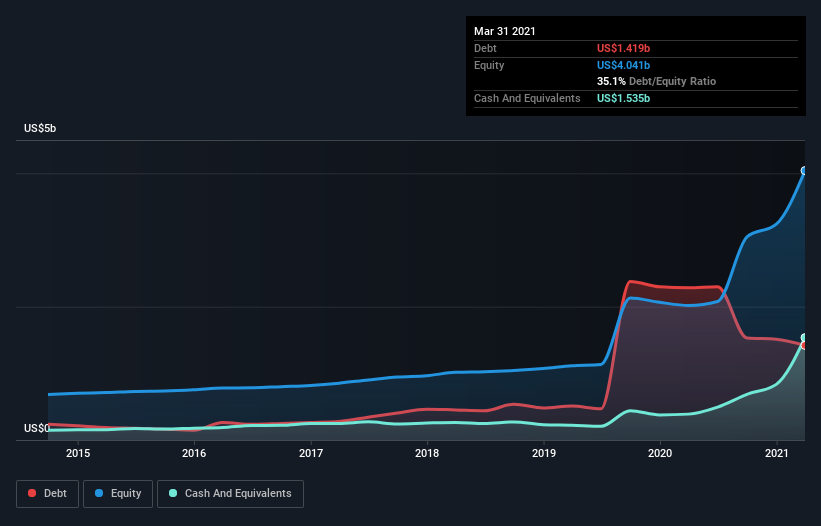Is II-VI (NASDAQ:IIVI) Using Too Much Debt?
Legendary fund manager Li Lu (who Charlie Munger backed) once said, 'The biggest investment risk is not the volatility of prices, but whether you will suffer a permanent loss of capital.' It's only natural to consider a company's balance sheet when you examine how risky it is, since debt is often involved when a business collapses. As with many other companies II-VI Incorporated (NASDAQ:IIVI) makes use of debt. But the more important question is: how much risk is that debt creating?
What Risk Does Debt Bring?
Debt and other liabilities become risky for a business when it cannot easily fulfill those obligations, either with free cash flow or by raising capital at an attractive price. If things get really bad, the lenders can take control of the business. However, a more usual (but still expensive) situation is where a company must dilute shareholders at a cheap share price simply to get debt under control. Having said that, the most common situation is where a company manages its debt reasonably well - and to its own advantage. When we examine debt levels, we first consider both cash and debt levels, together.
View our latest analysis for II-VI
How Much Debt Does II-VI Carry?
You can click the graphic below for the historical numbers, but it shows that II-VI had US$1.42b of debt in March 2021, down from US$2.28b, one year before. However, its balance sheet shows it holds US$1.54b in cash, so it actually has US$116.5m net cash.
How Strong Is II-VI's Balance Sheet?
According to the last reported balance sheet, II-VI had liabilities of US$678.8m due within 12 months, and liabilities of US$1.64b due beyond 12 months. Offsetting this, it had US$1.54b in cash and US$615.2m in receivables that were due within 12 months. So its liabilities total US$169.9m more than the combination of its cash and short-term receivables.
Since publicly traded II-VI shares are worth a total of US$7.46b, it seems unlikely that this level of liabilities would be a major threat. However, we do think it is worth keeping an eye on its balance sheet strength, as it may change over time. While it does have liabilities worth noting, II-VI also has more cash than debt, so we're pretty confident it can manage its debt safely.
Notably, II-VI's EBIT launched higher than Elon Musk, gaining a whopping 103% on last year. When analysing debt levels, the balance sheet is the obvious place to start. But ultimately the future profitability of the business will decide if II-VI can strengthen its balance sheet over time. So if you want to see what the professionals think, you might find this free report on analyst profit forecasts to be interesting.
Finally, a business needs free cash flow to pay off debt; accounting profits just don't cut it. II-VI may have net cash on the balance sheet, but it is still interesting to look at how well the business converts its earnings before interest and tax (EBIT) to free cash flow, because that will influence both its need for, and its capacity to manage debt. During the last three years, II-VI produced sturdy free cash flow equating to 78% of its EBIT, about what we'd expect. This cold hard cash means it can reduce its debt when it wants to.
Summing up
While it is always sensible to look at a company's total liabilities, it is very reassuring that II-VI has US$116.5m in net cash. And it impressed us with its EBIT growth of 103% over the last year. So we don't think II-VI's use of debt is risky. Above most other metrics, we think its important to track how fast earnings per share is growing, if at all. If you've also come to that realization, you're in luck, because today you can view this interactive graph of II-VI's earnings per share history for free.
When all is said and done, sometimes its easier to focus on companies that don't even need debt. Readers can access a list of growth stocks with zero net debt 100% free, right now.
This article by Simply Wall St is general in nature. It does not constitute a recommendation to buy or sell any stock, and does not take account of your objectives, or your financial situation. We aim to bring you long-term focused analysis driven by fundamental data. Note that our analysis may not factor in the latest price-sensitive company announcements or qualitative material. Simply Wall St has no position in any stocks mentioned.
Have feedback on this article? Concerned about the content? Get in touch with us directly. Alternatively, email editorial-team (at) simplywallst.com.

